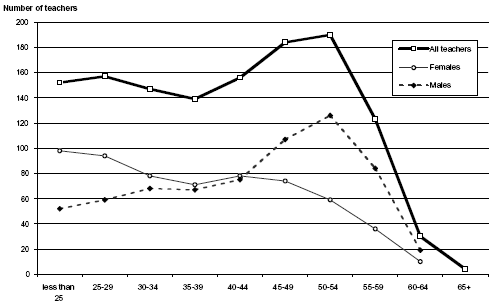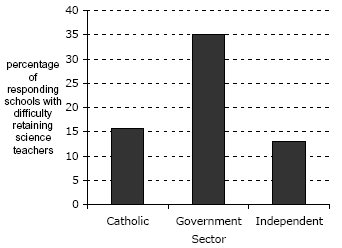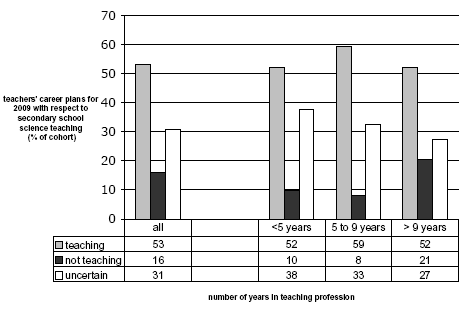|
Opinion- 29 December 2005 |

Science and Mathematics teaching in secondary schools is a bit like the weather -- both engender a lot of discussion but very little seems to get done about them. The inadequacy of the training of those who are required to teach maths and science subjects in secondary schools continues to be the cause of serious concern, and despite all the talk and reviews by the Minister for Education, Science and Training, Brendan Nelson, there has been little if any discernable improvement during his tenure as minister.
In 2000, Jan Thomas, Executive Officer of the Australian Mathematical Sciences Institute, estimated that about 40% of teachers of mathematics instructing students in their first year of Australian secondary schooling were under-qualified. While the estimate was based on a small data sample, the figure has not been challenged by the Department of Education, Science and Training.
And in April this year TFW reported, "The matter of the secondary school teaching of the enabling sciences has come 'round once again. While the Minister for Education Science and Training is preening over his Australian Government's Innovation Report 2004-05 the Australian Council of Deans of Science (ACDS) have issued a report which concludes that high school science students are being instructed by teachers with only a basic grasp of physics and chemistry.
"The deans' study, Who's Teaching Science? declares, 'There are people teaching secondary school science who have low levels of academic preparation, if any, and the situation may worsen,' and Australian schools will face a chronic shortage of science teachers within 10 years, as the bulk of baby boomers retires."
In the chart below the term "teachers" refers to the 1207 teachers of biology, chemistry, geology or physics who responded to the ACDS' survey.

The ACDS study summarises its "Key Findings":
Nearly 43 per cent of senior school physics teachers lacked a physics major, and one in four had not studied the subject beyond first-year. This, coupled together with the reported difficulties in attracting physics teachers (40 per cent of schools surveyed), paints an alarming picture. No matter how good their pedagogical skills, teachers who lack knowledge in their discipline are manifestly unprepared.
Among senior school chemistry teachers, one in four lacked a chemistry major, whereas 14 per cent of senior school biology teachers lacked a biology major.
There is a clear preference among heads of secondary school science departments for staff with a university degree in science supplemented by an education qualification, rather than a university degree in teaching with some study in science.
There is agreement among heads of secondary school science departments that, in future, teachers of senior science should have at least a major in the appropriate discipline area – a view supported by the ACDS.
There is a relatively high percentage of Year 7 / 8 teachers with no university exposure to any of the four surveyed disciplines [physics, chemistry, geology and biology]: even at the senior years of schooling, up to 6 per cent of teachers have not studied these subjects beyond first year at university, if at all.
There is concern of the heads of secondary school science departments at the difficulty in recruiting suitably qualified staff, especially in light of the age profile of existing staff: more than one third of male science teachers are at least 50 years of age.
There is a need for early career teachers to have effective mentoring.
The ACDS then observes:
Most heads of secondary school science departments defined the minimum qualification necessary to teach senior school science classes as an undergraduate university degree with a major in the relevant discipline. Far fewer believed that a major was essential for teaching earlier year levels. Half of the respondents were satisfied with ‘some first year subjects’ in science at university as adequate preparation for teaching Years 7 and 8, while most believed that a background in university science at second year level was necessary for teachers of Years 9 and 10.
Secondary schools had difficulty recruiting suitably qualified teachers for senior school classes in Chemistry and Physics. This was most acutely experienced when schools had short-term (e.g. six month) vacancies to fill. Most heads of secondary school science departments were satisfied with the qualifications of their teaching staff, but many suggested that replacing retiring staff would become increasingly difficult.
In contrast to the shortage of teachers with a strong background in Chemistry or Physics, there appeared to be no shortage of Biology teachers seeking secondary school teaching positions.
Geology was taught by a small number of schools, and so the fact that few heads seemed concerned about a shortage of teachers in this discipline is unsurprising. The predominant reason for schools not offering Geology was lack of demand from students rather than difficulty in staffing Geology classes with suitably qualified teachers.
And the ACDS' overall conclusions:
On any reasonable assessment of the research findings, the picture is troubling. There are people teaching secondary school science who have low levels of academic preparation, if any, and the situation may worsen. Consideration might be given to new strategies for encouraging young people to consider science teaching as a career and for the opportunities for attracting people with appropriate science qualifications who are in early and mid-career and working in other fields. Part of the challenge is to raise the appeal of teaching and of teaching science in particular. The evidence from this study is that teaching science in schools is currently considered to be a less glamorous alternative to working in industry and certainly a less financially rewarding one. This problem may well be characteristic of the teaching profession as a whole, but is perhaps of particular significance in the field of science where the lure to work on leading-edge developments in other, well-resourced environments is apparently very strong.
The science teachers who responded to this study had a common love of science and a desire to share this enthusiasm with young people. This commitment appeared to be being tested for many. Imaginative solutions are needed for some of the issues and problems identified by this study. Australian universities have a major responsibility to ensure the nation has well trained scientists and a suitable level of scientific literacy within the community. This work starts in schools and with the training and development of the next generation of science teachers. For this reason, the higher education system should play a leadership role in initiating an analysis and discussion of the future supply of science teachers and the quality of science teaching well before a crisis point is reached.
The two charts below illustrate the problem of attrition confronting the future of secondary science education beginning before the middle of the next decade.


Mind you, have either the federal or state governments shown significant proactivity to suggest that any of them really believe that a concerted effort is warranted to raise the scientific and mathematical competence of the nation? Over the years they have become dab hands at obfuscation, none more so than the current federal Coalition.
For example we are told how many more dollars are being spent for this or that educational or scientific initiative, but care is taken not to place the expenditures in the context of the nation's gross domestic product over an appropriate time period, or relative to that of appropriations of an appropriate cohort of nations or our nation's increased population and changing requirements.
It is certainly true that a knowledgeable teacher can be dull and uninspiring, but teachers who don't know their subjects and who don't keep up with advances in them will be detriments to the subjects for which they have teaching responsibility and will be quickly found out by all but the dullest of pupils.
But what's it take to inspire good prospective teachers of science and mathematics to take up the calling.
In a phrase -- tertiary teachers who inspire together with career and financial incentives.
Has Brendan Nelson as the "Father of all Reviews" taken up that challenge, and were he to do so, how would he set about implementing what's required?
But really isn't the primary question -- does either the the federal Coalition or its opposition, or the state governments and their oppositions, see the matter of the quality of science and mathematics teaching and the ability to inspire interest in them to be of importance (or should we ask political consequence)?
So far while Dr. Nelson's review documents appear to be multiplying like wire coat hangers in dark closets, there is nothing in the initiatives that have been put forward over his name, let alone implemented, to suggest that the federal government is serious about improving the quality of secondary school science and mathematics teaching.
|
Alex Reisner
The Funneled Web